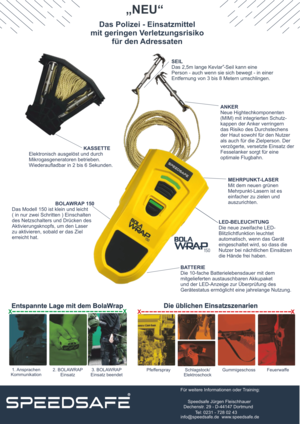The Impact of Bolawrap on Law Enforcement in Canada

Introduction
The use of non-lethal tools in law enforcement has gained traction in recent years, as agencies strive to enhance public safety while minimizing harm. One such tool, the Bolawrap, has emerged as a revolutionary device designed to assist officers in restraining individuals without physical confrontation. As tensions around policing methods continue to evolve, understanding the importance of the Bolawrap and its relevance to law enforcement is crucial for communities across Canada.
What is Bolawrap?
The Bolawrap, developed by Wrap Technologies, is a remote restraint device that discharges a tether to entangle and immobilize a person from a distance of up to 25 feet. The device utilizes a replaceable cartridge that propels a cord with two weights designed to wrap around the individual’s legs, limiting their movement without the use of physical force. Introduced into various police departments in the U.S. and beginning to gain attention in Canada, the Bolawrap’s aim is to provide a safer alternative to traditional restraint methods.
Recent Developments
In a press release earlier this year, Wrap Technologies announced that several Canadian police forces have begun exploring the use of Bolawrap in their operations. In June 2023, the Toronto Police Service conducted pilot programs, assessing Bolawrap’s effectiveness in various scenarios including mental health crises and combative individuals. Chief of Police, Myron Demkiw, stated, “We are committed to exploring non-lethal options that enhance the safety of both our officers and the public.” This pilot program comes in the wake of increased scrutiny on police use of force and aims to promote a more compassionate approach to law enforcement.
Benefits and Challenges
The Bolawrap offers several potential benefits. By providing officers with a non-lethal option, it can decrease the likelihood of injuries to both officers and suspects, while also aiming to reduce the number of fatal encounters. Furthermore, the device can enhance the ability of officers to manage volatile situations more effectively. However, challenges remain, including concerns over the potential misuse of the technology, effectiveness in various environments, and the need for comprehensive officer training.
Conclusion
The evolving landscape of law enforcement tools like the Bolawrap reflects a significant shift towards prioritizing de-escalation and non-lethal interventions. As Canadian police departments explore the integration of such devices, ongoing discussions about best practices and community implications will be essential. Ultimately, the successful adoption of the Bolawrap could lead to improved outcomes in police interactions, providing a promising step towards reforming approaches to public safety.









